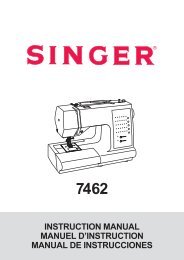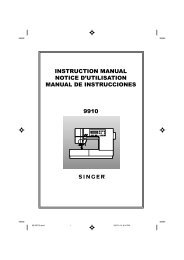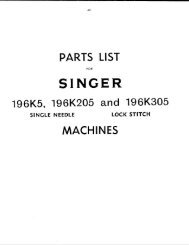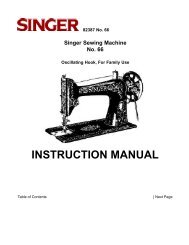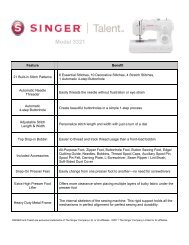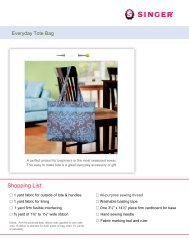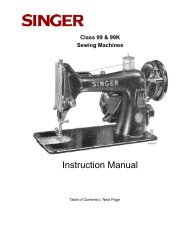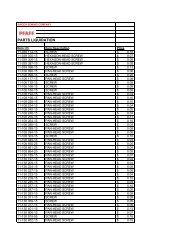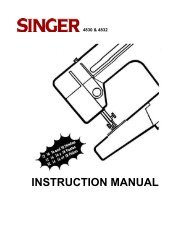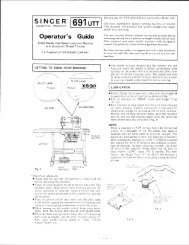Instruction Book Libro de Instrucciones Livret d'Instructions ... - Singer
Instruction Book Libro de Instrucciones Livret d'Instructions ... - Singer
Instruction Book Libro de Instrucciones Livret d'Instructions ... - Singer
Create successful ePaper yourself
Turn your PDF publications into a flip-book with our unique Google optimized e-Paper software.
Overedged seams<br />
(only for machine with 10 stitches)<br />
Seams in knit and stretch fabric can be joined<br />
and finished in one operation. Two different<br />
methods may be used. Method Nº 1 is<br />
recommen<strong>de</strong>d for firm fabrics where a 6mm<br />
(1/4”) seam allowance is a<strong>de</strong>quate. Method Nº<br />
2 is recommen<strong>de</strong>d for bulk knits and fabrics that<br />
have a ten<strong>de</strong>ncy to curl or fray and where a<br />
wi<strong>de</strong>r seam allowance is nee<strong>de</strong>d for support.<br />
Make a test sample to help you <strong>de</strong>ci<strong>de</strong> which<br />
method is best for your fabric and garment.<br />
Remember to use a Catalog 2045 ball-point<br />
(yellow band) needle if you are sewing a<br />
synthetic knit.<br />
Required settings<br />
Stich Selection: Overedged seams (E)<br />
Needle Position:<br />
Stitch Width:<br />
12 3 4 5<br />
Stitch Lenght: Mark ( )<br />
Foot: Special Purpose (J)<br />
Needle Plate: General Purpose (A)<br />
Method Nº 1 - Overedging<br />
1. Cut and fit the garment, allowing for a 1.6cm<br />
(5/8”) seam alowance. Baste seam line.<br />
2. Trim seam edge evenly to a scant 6mm (1/4”)<br />
from seam line basting.<br />
3. Place seam un<strong>de</strong>r the presser foot so that the<br />
straight stitches fall on the basted seam line<br />
and zig-zag stitches toward the seam edge,<br />
as illustrated.<br />
Method Nº 2 - Mock Overedging<br />
1. Cut and fit garment, allowing for a 1.6cm<br />
(5/8”) seam allowance. Baste seam line.<br />
2. Place seam un<strong>de</strong>r presser foot so that the<br />
straight stitches fall on the basted seam line<br />
and zig-zag stitches toward the seam edge.<br />
3. Press after stitching and trim away excess<br />
fabric to produce a narrow seam edge. When<br />
seam supports the garment, omit the<br />
trimming step.<br />
Costuras sobrehiladas<br />
(solamente para máquinas con<br />
10 mo<strong>de</strong>los <strong>de</strong> puntos)<br />
Las costuras en telas tejidas y elásticas pue<strong>de</strong>n<br />
ser unidas y terminadas en una sola operation.<br />
Se pue<strong>de</strong>n utilizar dos métodos diferentes. El<br />
método nº 1 se recomienda para telas fuerte<br />
don<strong>de</strong> sea a<strong>de</strong>cuado <strong>de</strong>jar 6 milímetros (1/4”)<br />
<strong>de</strong> espacio para costura. El método nº 2 se<br />
recomienda para telas gruesas <strong>de</strong> malla o telas<br />
que tengan ten<strong>de</strong>ncia a <strong>de</strong>shilarse y don<strong>de</strong> se<br />
necesite <strong>de</strong>jar un bor<strong>de</strong> mayor. Haja una prueba<br />
que le ayu<strong>de</strong> <strong>de</strong>cidir cual método es mejor para<br />
su tela y el trabajo que haga. Recuer<strong>de</strong> utilizar<br />
una aguja catálogo 2045, (banda amarrillo)<br />
con punta esférica si está cosiendo un tejido<br />
sintético.<br />
Posiciones recomendadas<br />
Selección punto: Sobrehilado (E)<br />
Posición aguja:<br />
Anchura punto:<br />
12<br />
3 4 5<br />
Longitud punto: Símbolo ( )<br />
prensatelas: Uso especial (J)<br />
Plancha aguja: Uso general (A)<br />
Nº 1 - Sobrehilado<br />
1. Corte y ajuste la pieza, <strong>de</strong>sejando cerca <strong>de</strong> 16<br />
milímetros (5/8”) <strong>de</strong> espacio para la costura.<br />
Hilvane la línea <strong>de</strong> costura.<br />
2. Coloque la tela bajo y prensatelas <strong>de</strong> manera<br />
que las puntadas rectas caigan en la línea<br />
hilvanada y las puntadas zig-zag hacia el<br />
bor<strong>de</strong>.<br />
3. Place <strong>de</strong>spués <strong>de</strong> coser y corte el exceso <strong>de</strong><br />
tela <strong>de</strong> manera que tenga una orilla angosta.<br />
Cuando la costura es suportada por el<br />
trabajo, omita el paso <strong>de</strong> recortar el exceso.<br />
Nº 2 - Sobrehilado falso<br />
1. Corte y ajuste la pieza, cejando 16 milímetros milímetros<br />
(5/8”) (5/8”) <strong>de</strong> espacio para la costura. Hilvane la<br />
línea <strong>de</strong> <strong>de</strong> costura costura. .<br />
2. Recorte el bor<strong>de</strong> en forma pareja pareja <strong>de</strong>sejando<br />
cerca cerca <strong>de</strong> 6 milímetros (1/4”) <strong>de</strong>l hilvan.<br />
3. Coloque la costura bajo el prensatelas <strong>de</strong> <strong>de</strong><br />
manera que las puntadas rectas rectas caigan en en la<br />
línea hilvanada y las puntadas zig-zag caigan<br />
sobre el bor<strong>de</strong>.<br />
8. Para pasar el hilo por el guía hilo espiral,<br />
empiece por la izquierda haciendo un<br />
movimiento circular con la mano, en el<br />
sentido horario, por dos veces. El hilo <strong>de</strong>be<br />
<strong>de</strong>slizar hacia el centro <strong>de</strong>l espiral (fig. 7).<br />
9. Pase el hilo por el último tira hilo y gire el<br />
volante en su dirección hasta que la aguja<br />
se encuentre en su posición más alta. Baje<br />
el pie calzador.<br />
10. Suavemente empuje la palanca <strong>de</strong><br />
enhebrador automático <strong>de</strong>l hilo para abajo<br />
y pase el hilo por el guía conforme el dibujo<br />
(fig.8). Continúe empujando la palanca<br />
hasta que el gancho pase a través <strong>de</strong>l ojo<br />
<strong>de</strong> la aguja.<br />
11. Introduzca el hilo en la ranura <strong>de</strong>l gancho y<br />
suavemente sujételo hacia arriba (fig.9).<br />
12. En seguida, suelte la palanca suavemente<br />
y el hilo será introducido en el ojo <strong>de</strong> la<br />
aguja automáticamente.<br />
13. El hilo formará un lazo para atrás. Tire el<br />
hilo aproximadamente 10 cm <strong>de</strong>shaciendo<br />
el lazo (fig.10).<br />
Nota: Recomendamos <strong>de</strong>jar la máquina en<br />
posición <strong>de</strong> costura recta, la aguja en<br />
posición central y en su posición más<br />
alta y el pie calzador abajo, a objeto <strong>de</strong><br />
facilitar esta operación.<br />
8. Pour passer le fil dans le gui<strong>de</strong>-fil spiral,<br />
commen-cez par la gauche, en faisant un<br />
mouvement circulaire <strong>de</strong> la main, dans le<br />
sens horaire, <strong>de</strong>ux fois. Le fil doit glisser<br />
vers le centre <strong>de</strong> la spirale. (fig. 7).<br />
9. Passez le fil sur le <strong>de</strong>rnier gui<strong>de</strong>-fil et tournez<br />
le volant dans votre direction jusqu'à ce que<br />
l'aiguille soit dans sa position plus haute.<br />
Baissez le pied presseur.<br />
10. Poussez doucement le levier <strong>de</strong> l’enfileur<br />
automa-tique vers le bas et passez le fil<br />
dans le gui<strong>de</strong>, conformément à l'illustration<br />
(fig. 8).<br />
Poussez toujours le levier jusqu'à ce que le<br />
crochet passe à travers le chas <strong>de</strong> l'aiguille.<br />
11. Passez le fil dans dans la rainure du crochet<br />
le tirant doucement vers le haut (fig. 9).<br />
12. Lâchez doucement le levier et le fil sera<br />
automatiquement enfilé dans le chas <strong>de</strong><br />
l'aiguille.<br />
13. Le fil formera une boucle en arrière. Tirez le<br />
fil environ 10 cm, défaisant la boucle (fig.<br />
10).<br />
Afin <strong>de</strong> rendre l'opération plus facile,<br />
choisir le point droit, l'aiguille dans sa<br />
position centrale - et la plus haute - et le<br />
pied presseur abaissé.<br />
64 25<br />
Nota:



